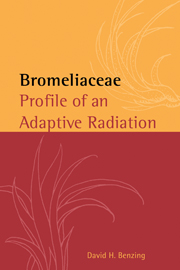Book contents
- Frontmatter
- Contents
- List of contributors
- Preface
- Acknowledgments
- Glossary
- Abbreviations
- Part one Brief overview
- Part two Basic structure, function, ecology and evolution
- 2 Vegetative structure
- 3 Reproductive structure
- 4 Carbon and water balance
- 5 Mineral nutrition
- 6 Reproduction and life history
- 7 Ecology
- 8 Relationships with fauna
- 9 History and evolution
- Part three Special topics
- Literature cited
- Name index
- Subject index
- Taxon index
6 - Reproduction and life history
from Part two - Basic structure, function, ecology and evolution
Published online by Cambridge University Press: 19 January 2010
- Frontmatter
- Contents
- List of contributors
- Preface
- Acknowledgments
- Glossary
- Abbreviations
- Part one Brief overview
- Part two Basic structure, function, ecology and evolution
- 2 Vegetative structure
- 3 Reproductive structure
- 4 Carbon and water balance
- 5 Mineral nutrition
- 6 Reproduction and life history
- 7 Ecology
- 8 Relationships with fauna
- 9 History and evolution
- Part three Special topics
- Literature cited
- Name index
- Subject index
- Taxon index
Summary
Reproduction is central to the evolutionary theme of this volume, but an uneven literature precludes a balanced treatment. Numerous reports deal with issues like pollination, while a host of other subjects (e.g., breeding systems) remain largely ignored. Reasons for the disparity range from botanical tradition to differences in the ease and costs of pursuing specific kinds of inquiry. Publications on flower, fruit and seed structure exceed all others on bromeliad reproduction to the extent that even a reasonable overview of this material requires a separate chapter (Chapter 3). Issues such as seed dispersal and gene flow and demography, along with the other phenomena that influence reproductive success and evolution, receive first priority here.
A single, fundamental bauplan and life under often stressful growing conditions help explain why most Bromeliaceae share several defining aspects of natural history. Life cycles usually proceed slowly and several years to decades pass before the typical bromeliad produces the first of usually multiple seed crops (iteroparity) from branched, determinant shoots (Fig. 2.3). About half a dozen genera in Pitcairnioideae and Tillandsioideae also include one or more members that fruit just once (the monocarps) after some 15 to many additional years devoted solely to resource accumulation (Figs. 2.3B, 14.2C). Genets of the iteroparous types that survive long enough fragment into multiple, autonomous units, and especially successful genets of the most aggressive terrestrials dominate extensive habitat (e.g., Brokaw 1983; Murawski and Hamrick 1990).
Numerous less routine aspects of reproduction and life history accommodate specific Bromeliaceae to specific kinds of ecospace and growing conditions. Fruit and seed morphology indicate dispersal by wind, perhaps flowing water, several groups of vertebrates, ants and possibly some other invertebrates.
- Type
- Chapter
- Information
- BromeliaceaeProfile of an Adaptive Radiation, pp. 245 - 328Publisher: Cambridge University PressPrint publication year: 2000
- 2
- Cited by



